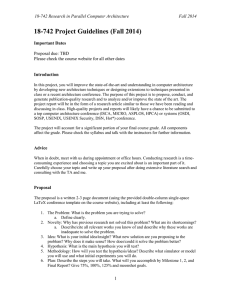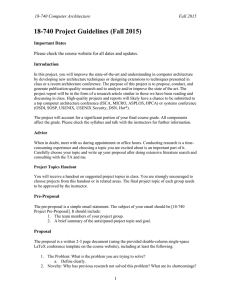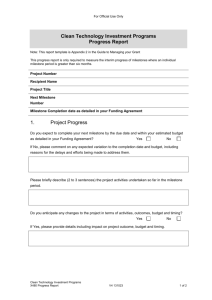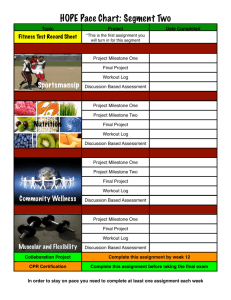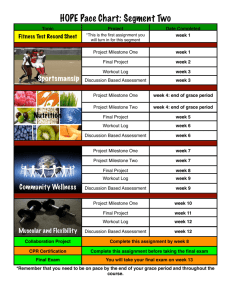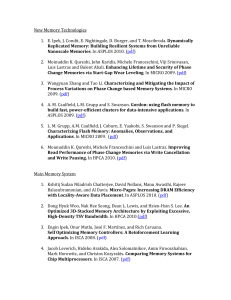Document 10770082
advertisement
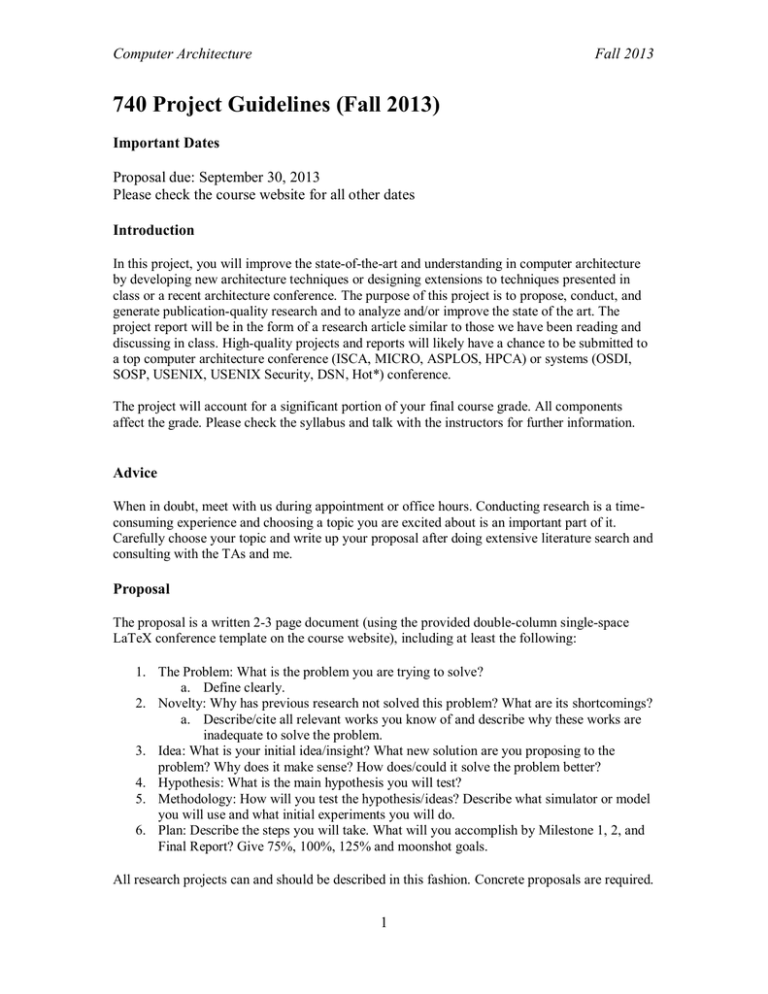
Computer Architecture Fall 2013 740 Project Guidelines (Fall 2013) Important Dates Proposal due: September 30, 2013 Please check the course website for all other dates Introduction In this project, you will improve the state-of-the-art and understanding in computer architecture by developing new architecture techniques or designing extensions to techniques presented in class or a recent architecture conference. The purpose of this project is to propose, conduct, and generate publication-quality research and to analyze and/or improve the state of the art. The project report will be in the form of a research article similar to those we have been reading and discussing in class. High-quality projects and reports will likely have a chance to be submitted to a top computer architecture conference (ISCA, MICRO, ASPLOS, HPCA) or systems (OSDI, SOSP, USENIX, USENIX Security, DSN, Hot*) conference. The project will account for a significant portion of your final course grade. All components affect the grade. Please check the syllabus and talk with the instructors for further information. Advice When in doubt, meet with us during appointment or office hours. Conducting research is a timeconsuming experience and choosing a topic you are excited about is an important part of it. Carefully choose your topic and write up your proposal after doing extensive literature search and consulting with the TAs and me. Proposal The proposal is a written 2-3 page document (using the provided double-column single-space LaTeX conference template on the course website), including at least the following: 1. The Problem: What is the problem you are trying to solve? a. Define clearly. 2. Novelty: Why has previous research not solved this problem? What are its shortcomings? a. Describe/cite all relevant works you know of and describe why these works are inadequate to solve the problem. 3. Idea: What is your initial idea/insight? What new solution are you proposing to the problem? Why does it make sense? How does/could it solve the problem better? 4. Hypothesis: What is the main hypothesis you will test? 5. Methodology: How will you test the hypothesis/ideas? Describe what simulator or model you will use and what initial experiments you will do. 6. Plan: Describe the steps you will take. What will you accomplish by Milestone 1, 2, and Final Report? Give 75%, 100%, 125% and moonshot goals. All research projects can and should be described in this fashion. Concrete proposals are required. 1 Computer Architecture Fall 2013 Literature Survey We will have a literature survey poster session related to your project. Check the website as course progresses. Milestone 1 In this milestone, you need to show preliminary experiments for your ideas. The format will be a short written report or a short presentation to the instructors/TAs. Milestone 2 The purpose of this milestone is to ensure that you are well ahead in executing your research plan. The format will be a short written report or a short presentation to the instructors/TAs. Final Report You will hand in a report in the conference submission style. Your final report should be formatted and written as if you are submitting the report to a top computer architecture conference. The report should include the following: - A descriptive title and author names Abstract Introduction (Problem and Motivation) Related Work and its Shortcomings Description of the Techniques (designed and evaluated) Evaluation Methodology Results and Analyses Conclusion/Summary Lessons Learned, Shortcomings, and Future Work Acknowledgements (if any) References (cited throughout the paper) The page limit is 12 double-column, single-spaced pages in the provided LaTeX template. Make sure your document is spell-checked and grammatically sound. Polished work is critical in getting a good grade in your project. Advice: The key characteristic that distinguishes a “good” research paper from a “bad” one is the existence of “clearly explained insight.” I expect the highest quality of writing as well as clear descriptions of the ideas and techniques from the final report. Even if your research results in a “negative result” (not all research ideas pan out to be useful – in fact few of them do) writing it in a very insightful and intuitive manner can make the 2 Computer Architecture Fall 2013 research very powerful and important. So, please do spend a significant amount of time and effort to ensure that your report is insightful and explains the ideas very clearly (possibly with examples and good analogies). Example of good final reports: http://users.ece.cmu.edu/~omutlu/pub/atlas_hpca10.pdf http://users.ece.cmu.edu/~omutlu/pub/tldram_hpca13.pdf Final Presentation/Poster In the last week of classes or during the final exam time we will hold presentation session(s) and/or a poster session in which teams get to present their projects and findings orally. More information on this will follow. Best Projects The top projects in class will be selected for submission to a computer systems conference for publication. In the past a number of papers from 740/741/742 have become full-blown research projects. For example, the TCM paper on fair and highperformance memory scheduling that appeared in MICRO 2010 and was selected to IEEE Micro Top Picks Issue was a 742 project in Spring 2010. The ATLAS paper on multiple memory controller scheduling that appeared in HPCA 2010 was a 741 project in Spring’09. The RAIDR paper that appeared at ISCA 2012 was a 740 project in Fall 2011. Similarly, the HotNets 2010 paper on Application-Aware Congestion Control in On-Chip Networks was a class project in 741, Spring 2009. Many other examples exist. Evaluation Techniques and Infrastructures You are welcome to use any infrastructure, tools, and benchmarks/applications that satisfy the needs of your project. However, you will need to justify why you use the infrastructure you choose. There are many simulation infrastructures available to perform experimental computer architecture research. Some of the tools you might find useful are provided on the course website are: Note that your proposed project does not have to use a simulator for evaluation. You can design real hardware, FPGA implementations, or even provide theoretical analyses. You only need to convincingly justify that your methodology is valid and satisfactory for the purposes of the project you propose. 3
